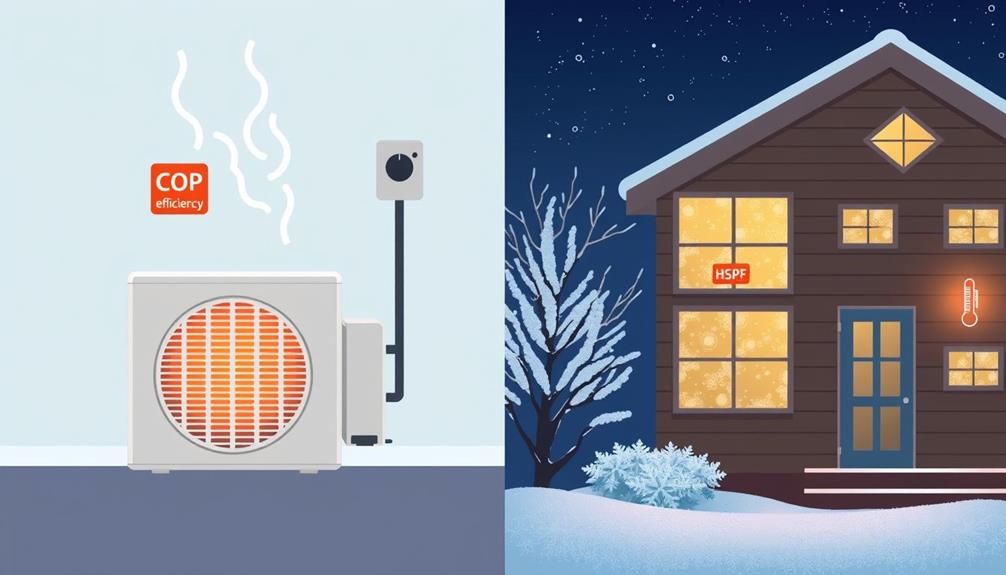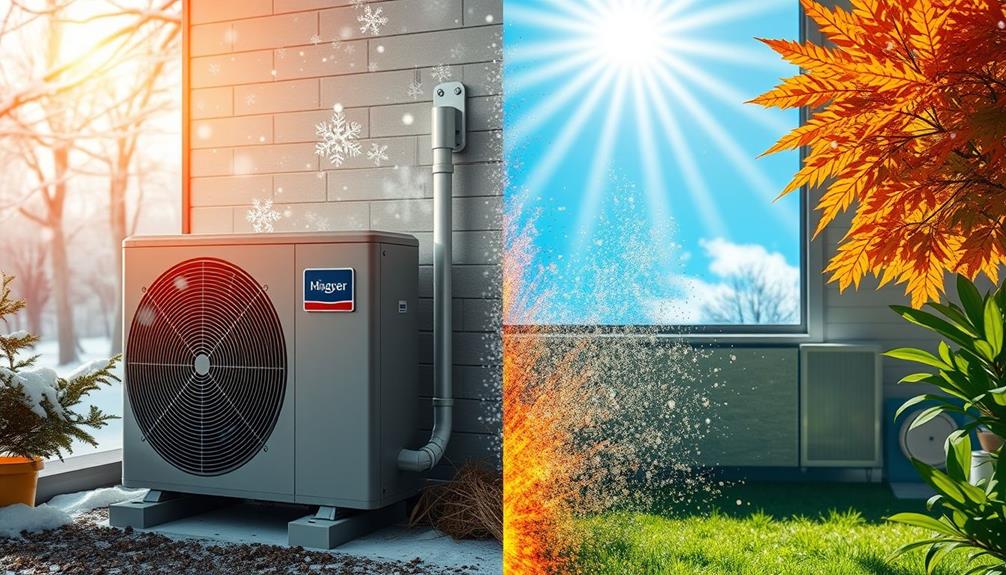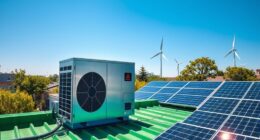Heat pump efficiency ratings like COP (Coefficient of Performance) and HSPF (Heating Seasonal Performance Factor) help you choose the right system for your home. COP measures the heat output compared to electrical energy, typically ranging from 2 to 4, with higher values indicating better efficiency. Meanwhile, HSPF evaluates heating performance over time, with modern models starting at 7.7 and high-efficiency units exceeding 10. Higher efficiency ratings mean lower energy bills and a reduced environmental impact. To optimize your comfort and savings, consider these metrics when selecting a heat pump and keep exploring for more insights on maximizing efficiency.
Key Takeaways
- Heat pump efficiency is measured using HSPF for heating, SEER for cooling, and COP for overall performance relative to energy consumption.
- HSPF ratings indicate heating efficiency, with newer units requiring at least 7.7, while high-efficiency models can exceed 10.
- SEER ratings reflect cooling efficiency, with a minimum requirement of 14 for new units, and many efficient models surpass 20.
- COP values range from 2 to 4, with higher values indicating greater efficiency, particularly affected by outdoor temperature conditions.
- Understanding these ratings helps consumers choose systems that optimize energy savings and environmental impact based on their climate needs.
Overview of Heat Pumps
Heat pumps are revolutionizing how we think about heating and cooling our homes. These energy-efficient systems transfer heat instead of generating it, making them ideal for both heating and cooling applications. Among the various types, air-source heat pumps are particularly popular due to their ability to effectively manage indoor climates while saving energy.
Additionally, understanding heat pump failures can help homeowners maintain their systems and avoid costly breakdowns. The efficiency of a heat pump is essential to its performance. The Heating Seasonal Performance Factor (HSPF) measures how well a heat pump operates in heating mode. A higher HSPF rating indicates better heating efficiency, with modern units typically starting at a minimum of 7.7. High-efficiency models can exceed 10, reflecting significant energy savings.
Another important metric is the Coefficient of Performance (COP), which generally ranges from 2 to 4. This indicates that heat pumps can produce two to four times more heat energy than the electrical energy they consume.
Importance of Efficiency Ratings

Efficiency ratings play an essential role in your decision-making process when selecting a heat pump for your home. They provide a clear indication of how well a unit will perform, affecting both your energy bills and environmental impact.
By understanding these ratings, you can choose a system that meets your heating needs efficiently. Additionally, similar to evaluating a home cleaning service, considering the efficiency ratings of heat pumps can help you identify the best options for your specific requirements.
Here's why efficiency ratings matter:
- SEER: A higher Seasonal Energy Efficiency Ratio indicates better energy efficiency and lower operating costs. New units must have a minimum SEER of 14, with some high-efficiency models exceeding 20.
- HSPF: The Heating Seasonal Performance Factor reflects the heating efficiency of a heat pump. New units should have an HSPF of at least 7.7, while those over 10 are considered highly efficient.
- Heat Pump Performance: Both SEER and HSPF ratings help you assess overall heat pump performance, guiding you towards units that will save energy.
Understanding COP Ratings

When evaluating heat pumps, understanding the Coefficient of Performance (COP) is essential. The COP measures a heat pump's efficiency by calculating the ratio of heat output to the electrical energy input. Typically, COP values range from 2 to 4, meaning a heat pump can deliver two to four times more heating or cooling than the energy it consumes. A higher COP indicates better efficiency, which can greatly lower your energy consumption and operational costs.
Additionally, utilizing high-quality pool maintenance equipment can enhance your overall home comfort, making it important to evaluate various products for improved efficiency.
It's important to acknowledge that COP values can fluctuate based on outdoor temperatures. In colder conditions, the COP for air-source heat pumps often decreases, as these systems work harder to extract heat from the outside air.
Under ideal circumstances, the theoretical maximum COP for an air-to-air heat pump operating between -5°C and 40°C can reach up to 6.95, showcasing its potential performance.
Exploring HSPF Ratings
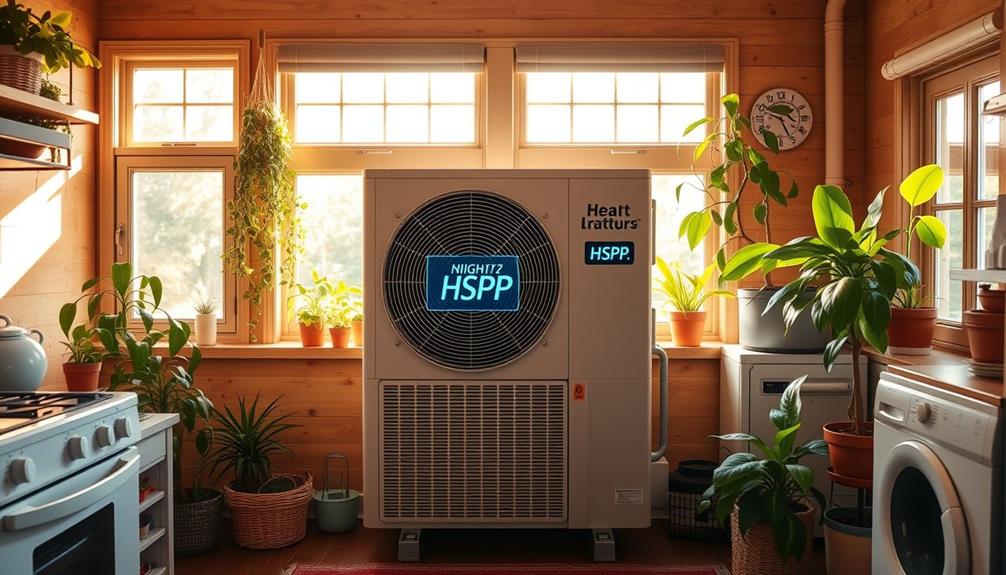
Understanding HSPF ratings is essential for anyone considering a heat pump, as these ratings directly impact your energy costs during the heating season.
The Heating Seasonal Performance Factor (HSPF) measures a heat pump's heating efficiency by calculating the total heating output in BTUs against the total electrical energy consumed in kilowatt-hours (kWh). Proper insulation and regular maintenance can further enhance a heat pump's efficiency, contributing to overall energy savings.
Additionally, effective weight loss strategies can support your energy efficiency goals by promoting a healthier lifestyle.
Here are a few key points to remember about HSPF ratings:
- A minimum HSPF rating of 7.7 is required for new units, while efficient models can exceed 10.
- HSPF values vary greatly by region, with climates like Miami achieving around 10.3, but Minneapolis may only reach about 4.6.
- Higher HSPF ratings indicate lower energy consumption and reduced operational costs during the heating season.
Seasonal Energy Efficiency Ratio (SEER)
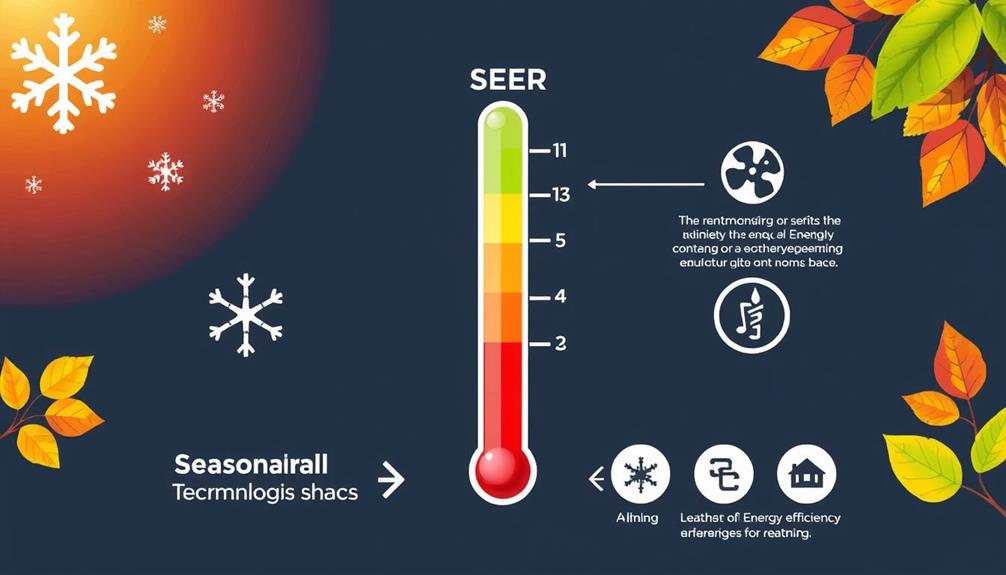
The Seasonal Energy Efficiency Ratio (SEER) is essential for understanding how efficiently your air conditioning system or heat pump cools your space.
A higher SEER rating indicates better energy efficiency, which can result in lower electricity bills and a more environmentally friendly option.
It's calculated by dividing the total cooling output during a season by the energy consumed, giving you insight into potential energy savings and costs.
Knowing the SEER rating can help you choose the right system for your climate and reduce your overall energy consumption, similar to how outdoor ceiling fans enhance comfort while being energy-efficient.
SEER Definition and Importance
SEER, or Seasonal Energy Efficiency Ratio, serves as an important metric for evaluating the cooling efficiency of air conditioning systems and heat pumps. This rating is calculated by dividing the total cooling output in BTUs by the total energy consumed in watt-hours over a cooling season.
Understanding SEER ratings is vital for making informed decisions, as they directly impact energy savings and operating costs. Additionally, considering the financial implications of energy-efficient systems can help in managing personal finances, especially as energy costs continue to rise. Many consumers are becoming more aware of their credit card management when investing in home improvements.
When considering a heat pump or air conditioning unit, keep these points in mind:
- A minimum SEER rating of 14 is required for new units in the U.S.
- Higher SEER ratings indicate better energy efficiency and can greatly reduce your energy bills.
- Energy Star-certified units typically boast SEER ratings above the minimum, promoting both energy efficiency and environmental sustainability.
Choosing a system with a higher SEER rating not only enhances cooling efficiency but also translates to long-term energy savings. By selecting a unit that meets or exceeds Energy Star standards, you can confirm you're making an environmentally conscious choice while enjoying the comfort of a well-cooled space.
Calculating SEER Ratings
When calculating SEER ratings, it's vital to understand how the total cooling output and energy consumption interact over a cooling season. The SEER measures the cooling efficiency of your air conditioning system or heat pump by dividing the total cooling output, typically measured in BTUs, by the total energy consumed in watt-hours. This ratio gives you a clear picture of energy efficiency.
Regular maintenance can promote peak performance, much like how maintenance extends the lifespan of the toilet by preventing issues and enhancing efficiency.
To calculate your unit's SEER, you'll need data on both the cooling output and the total energy consumed during the cooling season. Keep in mind that SEER ratings reflect a system's performance under standardized test conditions, accounting for typical seasonal variations rather than peak conditions.
A minimum SEER rating of 14 is required for new heat pumps sold in the U.S., while units achieving higher SEER ratings above 20 are considered highly efficient. Higher SEER ratings indicate better energy efficiency, which can lead to lower operating costs and a reduced environmental impact over the lifespan of your unit.
SEER and Energy Savings
Understanding how SEER ratings impact your energy savings is crucial for choosing an efficient heat pump. The Seasonal Energy Efficiency Ratio (SEER) measures the cooling efficiency of heat pumps and air conditioning systems. A higher SEER means more cooling output for less energy consumed, leading to significant energy savings.
Additionally, incorporating energy-efficient practices into your daily routine can further enhance your overall savings and sustainability, as highlighted in community support for health-related goals.
When evaluating heat pumps, consider these key points:
- Minimum Requirements: New heat pumps in the U.S. must have a minimum SEER rating of 14. Models exceeding 20 can drastically cut down energy consumption.
- Lower Operating Costs: Higher SEER ratings directly correlate with reduced operating costs, making it a crucial metric for your budget.
- Climate Considerations: SEER ratings can vary based on climate conditions, so choose a unit suited for your local environment to maintain ideal cooling efficiency.
Energy Star-certified heat pumps often surpass standard SEER ratings, ensuring better energy efficiency and potential eligibility for rebates. By focusing on SEER ratings, you can make informed decisions that enhance your energy savings while enjoying a comfortable home environment.
Energy Efficiency Ratio (EER)
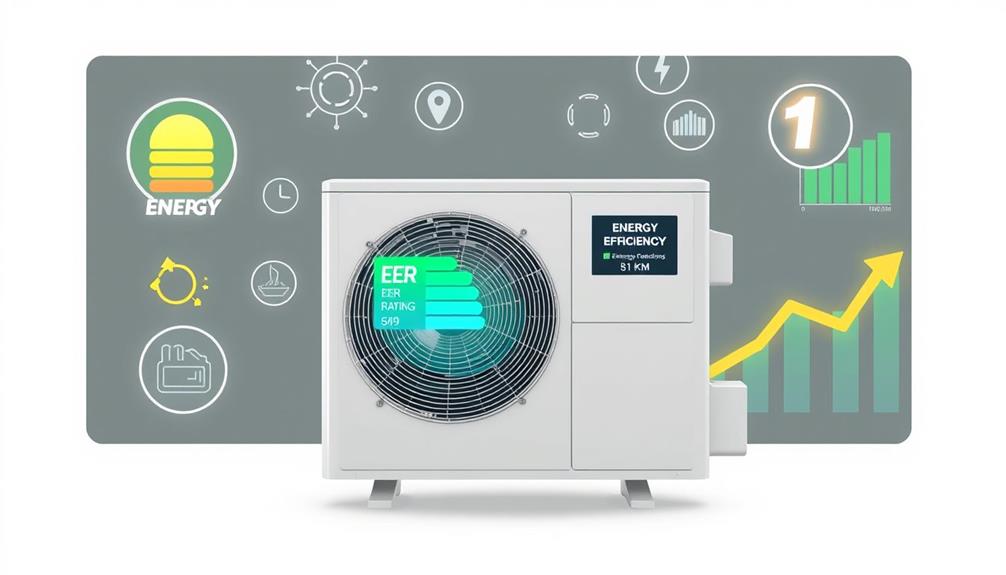
When you're looking at heat pumps, the Energy Efficiency Ratio (EER) is a key metric to evaluate. It measures how efficiently a system cools your space by comparing the cooling output to the electrical power it consumes.
Understanding EER, especially in comparison to SEER and the factors that affect it, can help you make smarter choices for energy savings.
Additionally, tracking user engagement metrics can provide insights into how well your heat pump is performing over time, further aiding in your energy efficiency decisions.
EER Definition and Importance
The Energy Efficiency Ratio (EER) is an important metric for evaluating the cooling efficiency of heat pumps and air conditioning systems.
It's calculated as the ratio of cooling output in Btu/h to electrical power input in watts (Btu/h/W). Understanding your system's EER can greatly impact your energy consumption and operational costs.
Additionally, factors such as air quality and the use of air purifiers can influence overall comfort levels in your home, making it vital to take into account how these systems work together.
Here are a few key points about EER:
- A higher EER indicates better cooling efficiency, with typical residential units ranging from 8 to 14.
- EER measures performance under specific conditions, reflecting operation at a fixed temperature rather than over an entire season.
- Compliance with regional efficiency benchmarks is often required for new units, emphasizing the importance of EER in selecting your system.
EER Vs. SEER Comparison
EER and SEER are both essential metrics for evaluating heat pump efficiency, but they serve different purposes.
The Energy Efficiency Ratio (EER) measures cooling efficiency under specific conditions, typically at an outdoor temperature of 95°F. It's expressed as Btu/h per watt of electrical power consumed. This means that a higher EER rating indicates better cooling efficiency at that fixed temperature.
On the other hand, the Seasonal Energy Efficiency Ratio (SEER) provides a broader perspective by evaluating heat pump performance over an entire cooling season. It accounts for varying temperature and humidity levels, making SEER a more reliable indicator of overall energy efficiency.
While EER focuses on performance at a single temperature, SEER captures how well the system performs across different conditions.
When comparing heat pumps, a higher EER signifies superior cooling efficiency at a specific temperature, whereas a higher SEER rating suggests better seasonal efficiency. This can lead to lower energy bills in diverse climates.
Understanding these ratings helps you make informed decisions when selecting heat pumps that best fit your energy efficiency needs.
Factors Affecting EER Efficiency
Several factors influence the Energy Efficiency Ratio (EER) of heat pumps, impacting their overall cooling performance. Understanding these factors helps you make informed decisions about your cooling systems and their operational costs.
- Outdoor Temperature: EER is calculated under specific temperature conditions. As outdoor temperatures rise, the cooling output may decrease, lowering the EER.
- Humidity Levels: High humidity can affect the cooling efficiency. Systems need to work harder to remove moisture, which can decrease the EER.
- System Design: The design and components of your heat pump directly influence its energy efficiency. A well-designed system tailored for your environment can achieve a higher EER.
A higher EER indicates better cooling efficiency, which is vital for reducing energy consumption and operational costs.
It's important to remember that EER values can vary considerably based on those factors. By considering outdoor temperature, humidity levels, and system design, you'll better understand how to select the most efficient heat pump for your needs.
This knowledge not only helps you save on energy bills but also contributes to a more sustainable environment.
Climate Impact on Ratings

Heat pump efficiency ratings are heavily influenced by climate, making it essential to understand how local weather patterns affect performance. The Heating Seasonal Performance Factor (HSPF) varies markedly across climate zones. For instance, while Minneapolis averages an HSPF of 4.6 due to its colder climate, Miami boasts a much higher average of 10.3. This stark contrast highlights how local climate impacts heating efficiency.
Additionally, performance metrics can drop considerably in extreme climate zones. In climate zone 5, heat pump efficiency can be about 83% of that in zone 4. Understanding these variations in efficiency ratings is vital for making informed decisions.
Here's a quick overview of HSPF adjustments by climate zone:
| Climate Zone | Average HSPF |
|---|---|
| Zone 1 | 3.5 |
| Zone 4 | 7.0 |
| Zone 5 | 6.0 |
When evaluating heat pump options, consider your local climate's effect on efficiency ratings. By being aware of these factors, you can set realistic expectations for your heat pump's heating efficiency and overall performance.
Choosing the Right Heat Pump
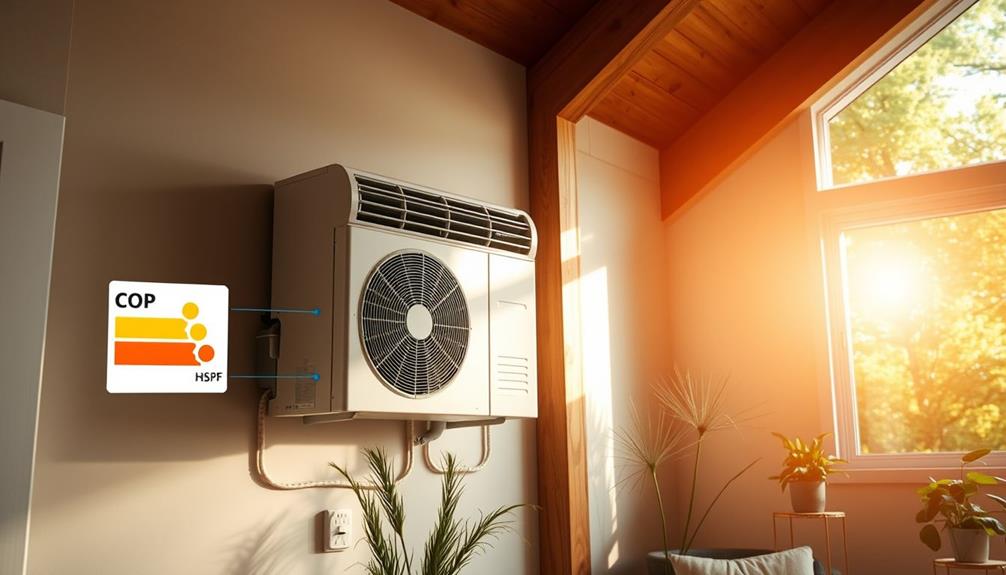
Selecting the right heat pump can greatly impact your home's energy efficiency and comfort. To make the best choice, you need to take into account several factors:
- HSPF Rating: Aim for a minimum of 7.7, with high-efficiency models exceeding 10.
- SEER Rating: Look for at least 14 for cooling efficiency, noting that 20 or higher indicates superior performance.
- Climate Compatibility: Choose between air-source heat pumps for moderate climates and geothermal systems for extreme temperatures.
Additionally, proper sizing is essential. Oversizing can lead to decreased efficiency and higher energy bills.
It's wise to consult a professional for Manual J calculations to guarantee your heat pump is the right fit for your space.
Don't forget to explore available rebates and incentives for energy-efficient models. Many regions offer financial assistance that can help offset your installation costs, making your investment in energy efficiency even more worthwhile.
Benefits of High Efficiency Systems
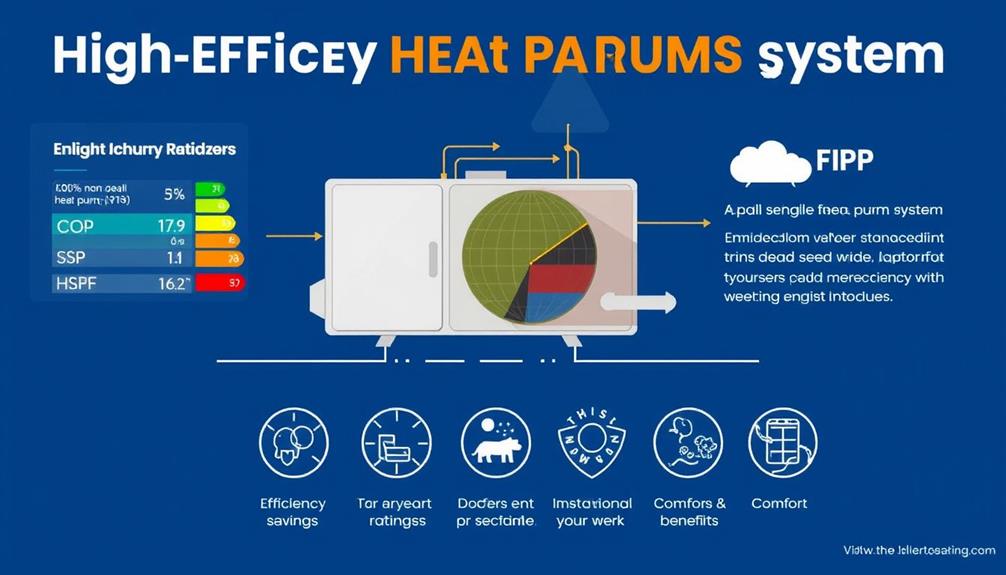
Investing in a high efficiency heat pump can lead to lower energy costs, as these systems provide more heating and cooling output for each unit of energy consumed.
You'll not only save money on your bills but also contribute to a healthier environment by reducing greenhouse gas emissions.
Plus, with improved comfort levels in your home, you'll enjoy a more consistent and pleasant indoor climate year-round.
Lower Energy Costs
When you choose high-efficiency heat pumps, you can considerably cut down on energy costs. With higher HSPF ratings, typically above 10, these systems provide efficient heating that traditional units can't match.
You'll notice a significant reduction in your annual heating bills, potentially by 30-50%, depending on your local climate.
Here are a few ways high-efficiency heat pumps help you save:
- Reduced Energy Bills: Utilizing heat pumps with SEER ratings of 20 or higher can lead to cooling energy savings of up to 50% compared to older systems.
- Lower Energy Expenditures: A heat pump's COP can range from 2 to 4, meaning for every unit of energy consumed, you get 2 to 4 units of heating or cooling.
- Rebates and Incentives: Investing in energy-efficient heat pumps can qualify you for various rebates, further decreasing your upfront costs and enhancing your savings.
Environmental Impact Reduction
High-efficiency heat pumps not only lower your energy costs but also play a notable role in reducing environmental impact. By choosing systems with elevated HSPF and SEER ratings, you can cut energy consumption by up to 50% compared to standard units. This reduction leads to lower greenhouse gas emissions, making your home a part of the solution to climate change.
These energy-efficient heat pumps lessen reliance on fossil fuels, markedly decreasing your carbon footprint. With a coefficient of performance (COP) of 3 or higher, these systems produce three times the energy they consume, showcasing their effectiveness in promoting sustainability.
Transitioning to high-efficiency systems can also qualify you for rebates and incentives, providing both environmental and financial benefits.
Additionally, increased efficiency in heat pumps reduces the overall demand on power plants, which diminishes air pollution and improves air quality in surrounding communities.
Enhanced Home Comfort
One of the standout advantages of high-efficiency heat pumps is their ability to maintain a comfortable home environment year-round. With a Heating Seasonal Performance Factor (HSPF) typically above 10, these systems provide consistent and effective heating during colder months.
You'll enjoy reduced energy costs while keeping your comfort levels high.
High efficiency heat pumps come with several benefits that enhance your home's comfort:
- Optimal Humidity Control: These systems maintain proper indoor humidity levels, improving air quality and promoting your health.
- Variable Speed Compressors: This feature adjusts output based on heating needs, minimizing temperature fluctuations and ensuring a stable indoor climate.
- Energy Efficiency: With a Coefficient of Performance (COP) ranging from 3 to 5, you receive three to five units of heating for every unit of energy consumed.
Regular maintenance, including filter management and system checks, is essential to preserving their efficiency.
Future of Heat Pump Technology
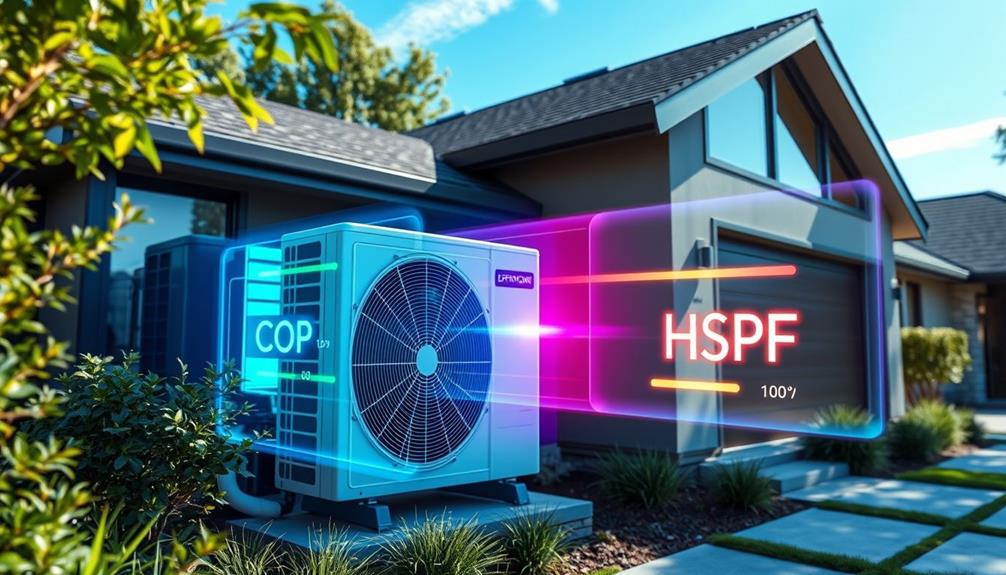
The future of heat pump technology promises significant advancements that prioritize energy efficiency and environmental sustainability.
You'll see innovative designs that enhance heat pump efficiency, allowing these systems to work smarter and save more energy. By integrating renewable energy sources like solar and geothermal, heat pumps can operate with reduced carbon footprints, making them even more eco-friendly.
Advancements in refrigerant technology will also play a key role in reducing global warming potential. As regulations tighten, you can expect heat pumps to comply with new standards while enhancing their climate performance.
Research is ongoing to improve heat pump reliability and efficiency in extreme climates, ensuring they meet your heating and cooling needs no matter where you live.
Moreover, the trend towards automation and IoT connectivity means you'll enjoy real-time monitoring and self-regulating systems. This technology not only enhances energy savings but also increases your comfort by adjusting to your preferences automatically.
As smart home technologies evolve, your heat pump system will seamlessly integrate into your home, creating a more efficient and eco-conscious living environment.
Embracing these innovations will certainly shape a more sustainable future for heat pump technology.
Frequently Asked Questions
What Is a Good HSPF for a Heat Pump?
A good HSPF for your heat pump is generally above 8. If you're in a warmer climate, aim for 9 to 10; in colder regions, look for 8 or higher to guarantee peak performance.
What Is the Difference Between COP and Hspf?
Imagine a chilly winter's night. COP measures instant efficiency, showing how well your heat pump performs at that moment. In contrast, HSPF reflects its overall efficiency throughout the entire season, revealing long-term savings.
What Is a Good COP Rating for a Heat Pump?
A good COP rating for a heat pump usually falls between 2 to 4. If you find a model exceeding 4, especially in mild climates, you've likely discovered an efficient option for your needs.
Is a Higher COP Better?
When it comes to heat pumps, think of COP as a shining star; the higher it is, the better. So yes, a higher COP means more efficiency, less energy use, and ultimately, lower bills for you.
Conclusion
To sum up, understanding heat pump efficiency ratings—like COP, HSPF, and SEER—can feel like cracking a secret code to energy savings. The right choice can not only keep your home comfortable but can also skyrocket your savings and reduce your carbon footprint. With technology advancing faster than a rocket ship, high-efficiency systems are becoming more accessible. So, take the plunge and embrace the future of heating and cooling—your wallet (and the planet) will thank you!
